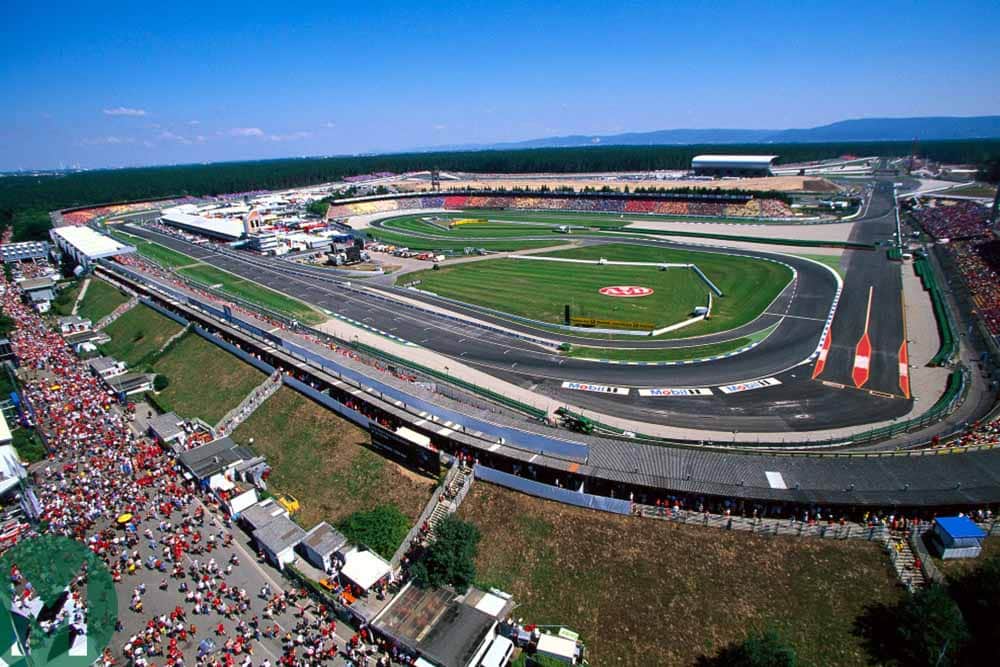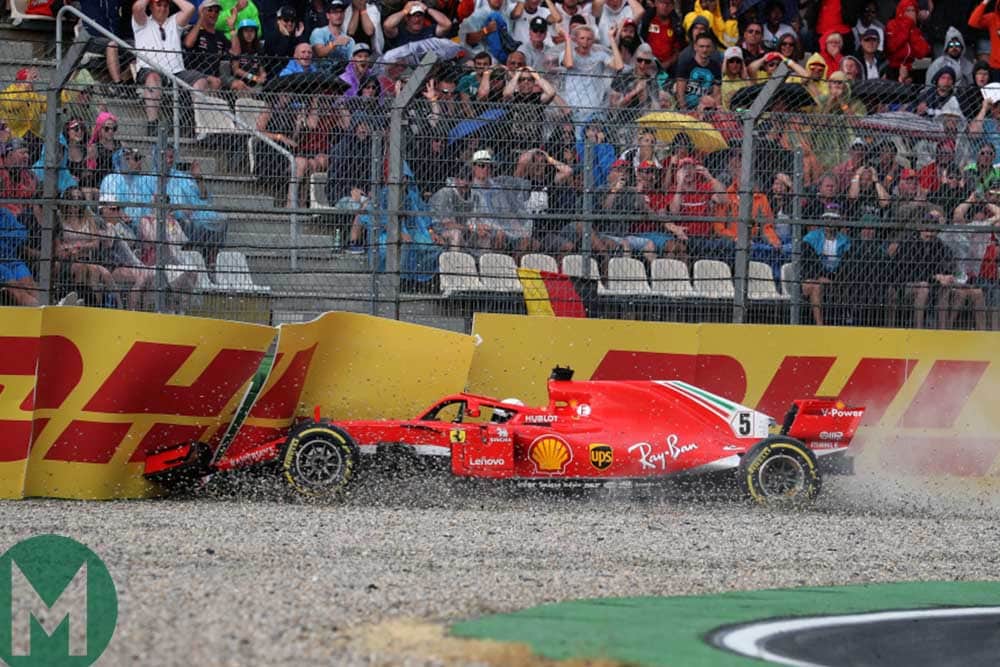
MPH: To the man trying to fill Christian Horner's shoes: good luck!
Laurent Mekies arrives as Red Bull F1 team principal with a series of immediate challenges to solve and long-term issues to tackle. He'll either sink or swim, says Mark Hughes
The 2019 German Grand Prix could very well be the final Formula 1 race Hockenheim hosts. Mark Hughes looks back at the many highlights the venue has produced over the years

The Hockenheim circuit’s layout changed in 2002, no longer carving out a route through the forest. Photo: Motorsport Images
Judging by how much stadium seating has been removed to make way for the new Porsche driving centre at Hockenheim, it looks like the venue is not expecting to be hosting the German Grand Prix beyond this one. Never say never, especially with F1 looking to increase the number of venues in order to make the financials work, but this weekend may mark the last time the circuit in southern Germany hosts a grand prix.
Back in the Schumacher heyday, Germany could support two grands prix, with one of them having to be named the European. But now, despite the stay of execution made possible by all the Max Verstappen fans who travel here, it’s not in a position to do a long term contract for the race.
So let’s do a fast-forwarded reminder of the place’s highlights. It’s a perfect case study of how the sport has evolved in the last 50 years. Before hosting the 1970 German Grand Prix at short notice because the F1 drivers refused to race at the Nürburgring Nordschleife until agreed safety improvements were made, Hockenheim was recalled only as the black place at which Jim Clark had lost his life in ’68. A suspected slow puncture around a 120mph kink in an F2 race surely shouldn’t have carried the penalty of violent death. But in a flat-out blast through a forest with no guardrails between you and the trees, how could it not?
“The former straights were re-wooded and would soon become unrecognisable as ever having been a race track. The site of Clark’s death lies now in a peaceful, secluded wood.”
This much at least had been recognised by the time F1 made its first visit there in ’70. Guard rails had been erected and the two long straights were punctuated by chicanes. The vast stadium seating arrangements foreshadowed the massive attraction that F1 would become in the following decades – and Hockenheim had that, long before F1 in general. There were over 100,000 at that inaugural F1 event, with thousands more camped out in the infield forest, where all sort of shenanigans took place, out of the wider public eye.
It was a slipstreaming circuit, a different sort of racing to more traditional road courses of the time, shared on the calendar only by Monza. So if your rival was anywhere close you couldn’t be rid of him. For the faster you went, the faster he was dragged along. Lotus’ Jochen Rindt and Ferrari’s Jacky Ickx did it this way, pulling ever-further clear of the field, but even before the final denouement of Rindt’s victory, Ickx suspected it was going to play that way. Rindt could get himself ahead whenever he chose – and so was obviously just going to time it right into the final lap. It looked a closer battle than it really was. That turned out to be Rindt’s final grand prix victory and the result which, in hindsight, clinched the championship he wouldn’t live to know about. Brutal.
They raced at the Nordschleife again for the next six years but Niki Lauda’s fiery accident there finally brought that game to an end. So it was hugely symbolic and very moving when Lauda won one year on from those Last Rites – at Hockenheim ‘77, a result that extended his lead in the world championship, putting him on-course for that second title.
Related content
A couple of years later Alan Jones took his first Williams Grand Prix victory, and so began a roll that would come to define a whole crucial force in F1 racing for the next couple of decades, long after Jones retired but never without a reminder of the stamp he’d left there.
In preparation for the 1980 race Patrick Depailler tested his Alfa-Romeo, with its titanium suspension. The catch fencing for the flat-in-top loop of Ostkurve was down for circuit maintenance. No-one bothered about it – and so with a suspected suspension failure, there was nothing to slow Depailler’s car and he perished right there. His close friend Jacques Laffite won the following week’s race. Of all the race’s he didn’t want to win – yet ironically it was Laffite’s only victory that year. He looked very conflicted with a victory garland around his neck.
In 1982 Didier Pironi’s career came to a violent end at the entrance to the stadium after hitting Alain Prost’s slow-moving Renault in heavy rain. Pironi – who’d already stuck his Ferrari on pole and was comfortably leading the world championship – had been unsighted by the spray and was pushing on even in this insignificant practice session. His pole slot was left empty and new Ferrari recruit Patrick Tambay magically took his first grand prix victory. He achieved this after leader Nelson Piquet collided with Eliseo Salazar’s ATS when lapping it – Piquet resultant kung-fu kick on his former friend now a YouTube favourite.
The Honda years passed by in a Hockenheim blur, first with Williams and Piquet, latterly with McLaren and Ayrton Senna. Williams-Renault was threatening the McLaren-Honda domination by ’91 and Nigel Mansell took the first of two copybook wins there, with his replacement Alain Prost following up in ’93. The ’94 race is probably remembered more for Jos Verstappen’s pitlane fire than Gerhard Berger’s victory for Ferrari – but Berger was always great around this place and repeated that feat in ’97 for Benetton after a couple of races away with illness and a family bereavement. It was his final victory but an emphatic one.
In 2000 Mika Hakkinen was all set to repeat his ’98 win here for McLaren-Mercedes when a track invader – protesting at his sacking from a Mercedes factory – caused the race to come under the safety car at the perfect time for Rubens Barrichello, enabling him to pit his Ferrari almost for free on his way to a maiden grand prix victory.

Sebastian Vettel crashes out of the lead of the 2018 German Grand Prix Photo: Motorsport Images
The circuit was changed radically for 2002, cutting out the long straights and re-routing a much shorter track through cleared forest. The former straights were re-wooded and would soon become unrecognisable as ever having been a race track. The site of Clark’s death lies now in a peaceful, secluded wood with birdsong overpowering the distant engines. Juan Pablo Montoya’s ’03 win for Williams-BMW was every bit as dominant as those of Michael Schumacher’s Ferrari of the previous and following years. Kimi Raikkonen was walking the 2005 race when his McLaren suffered a hydraulics failure – handing a crucial win to the Renault of title rival Fernando Alonso.
Alonso’s infamous ‘Fernando is faster than you’ Ferrari victory came here in 2010, at Felipe Massa’s expense. He’d repeat the win, without team orders, two years later. A brake failure that put Hamilton in the wall in 2014 qualifying paved the way for a Nico Rosberg win as Hamilton charged through to third from the back. It was not a dissimilar story to last year, with Hamilton starting only 14th after a burst hydraulics valve in qualifying left him down the order – from where he launched an unlikely victory drive, the rain coming to his aid, helping him run down Sebastian Vettel’s leading Ferrari, and perhaps contributing to Seb’s crashing out of the lead, a hugely significant moment in the championship contest between them.
So perhaps F1 bids farewell to this dramatic theatre of speed and drama. It would be great if it could go out in a suitably thrilling way on Sunday.

Laurent Mekies arrives as Red Bull F1 team principal with a series of immediate challenges to solve and long-term issues to tackle. He'll either sink or swim, says Mark Hughes

Former McLaren F1 team-mates Mika Häkkinen and David Coulthard are set to renew old rivalries in a new Evening with... tour – they told James Elson all about it

In Formula 1, driver contracts may look iron-clad on paper, but history shows that some of its biggest stars have made dramatic early exits

Former McLaren F1 ace told James Elson about his private audience with The Beatles' George Harrison, who played an unreleased grand prix-themed song